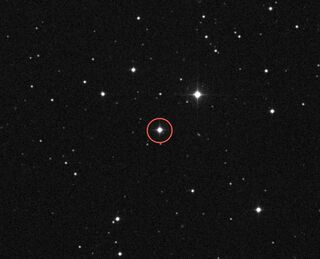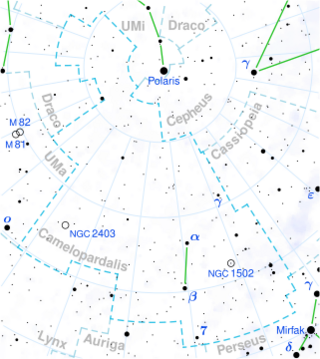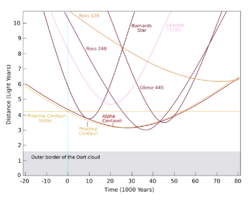Astronomy:Gliese 445
Coordinates: ![]() 11h 47m 41.3885s, +78° 41′ 28.179″
11h 47m 41.3885s, +78° 41′ 28.179″
| Observation data Equinox J2000.0]] (ICRS) | |
|---|---|
| Constellation | Camelopardalis |
| Right ascension | 11h 47m 41.3885s[1] |
| Declination | +78° 41′ 28.179″[1] |
| Apparent magnitude (V) | 10.80[2] |
| Characteristics | |
| Spectral type | M4.0Ve[3] |
| B−V color index | 1.572[2] |
| Astrometry | |
| Radial velocity (Rv) | −111.707[1] km/s |
| Proper motion (μ) | RA: 748.111[1] mas/yr Dec.: 480.804[1] mas/yr |
| Parallax (π) | 190.3251 ± 0.0194[4] mas |
| Distance | 17.137 ± 0.002 ly (5.2542 ± 0.0005 pc) |
| Absolute magnitude (MV) | 12.227[5] |
| Details | |
| Mass | 0.14[6] M☉ |
| Radius | 0.285[5] R☉ |
| Luminosity | 0.008[7] L☉ |
| Surface gravity (log g) | 4.72[7] cgs |
| Temperature | 3,507[1] K |
| Metallicity [Fe/H] | −0.30[5] dex |
| Rotational velocity (v sin i) | <2.5[8] km/s |
| Other designations | |
Gliese 445, Gl 445, G 254-29, AC+79 3888, HIP 57544, LFT 849, LHS 2459, LTT 13235, NLTT 28539, PLX 2722[9] | |
| Database references | |
| SIMBAD | data |
| ARICNS | data |
Gliese 445 (Gl 445 or AC +79 3888) is an M-type main sequence star in the northern part of the constellation Camelopardalis.
Location
It is currently 17.1 light-years from Earth and has an apparent magnitude of 10.8. It is visible from north of the Tropic of Cancer all night long, but not to the naked eye.[10] Because the star is a red dwarf with a mass only a quarter to a third of that of the Sun, scientists question the ability of this system to support life.[10] Gliese 445 is also a known X-ray source.[11]
The Voyager 1 probe will pass within 1.6 light-years of Gliese 445 in about 40,000 years.[12]
Solar encounter
While the Voyager probe moves through space towards a 1.6-light-year minimum distance from Gliese 445, the star is rapidly approaching the Sun. At the time the probe passes Gliese 445, the star will be about 1.059 parsecs (3.45 light-years) from the Sun,[13] but with less than half the brightness necessary to be seen with the naked eye.[10] At that time, Gliese 445 will be approximately tied with Ross 248 for being the closest star to the Sun (see List of nearest stars#Future and past).
See also
References
- ↑ 1.0 1.1 1.2 1.3 1.4 1.5 Brown, A. G. A. (August 2018). "Gaia Data Release 2: Summary of the contents and survey properties". Astronomy & Astrophysics 616: A1. doi:10.1051/0004-6361/201833051. Bibcode: 2018A&A...616A...1G. Gaia DR2 record for this source at VizieR.
- ↑ 2.0 2.1 Urban, S. E.; Zacharias, N.; Wycoff, Observatory G. L. U. S. Naval; Washington, 2004-2006 D. C. (2004). "VizieR Online Data Catalog: The UCAC2 Bright Star Supplement (Urban+, 2006)". VizieR On-line Data Catalog. Bibcode: 2004yCat.1294....0U.
- ↑ Lépine, Sébastien; Hilton, Eric J.; Mann, Andrew W.; Wilde, Matthew; Rojas-Ayala, Bárbara; Cruz, Kelle L.; Gaidos, Eric (2013). "A Spectroscopic Catalog of the Brightest (J < 9) M Dwarfs in the Northern Sky". The Astronomical Journal 145 (4): 102. doi:10.1088/0004-6256/145/4/102. Bibcode: 2013AJ....145..102L.
- ↑ Brown, A. G. A. (2021). "Gaia Early Data Release 3: Summary of the contents and survey properties". Astronomy & Astrophysics 649: A1. doi:10.1051/0004-6361/202039657. Bibcode: 2021A&A...649A...1G. Gaia EDR3 record for this source at VizieR.
- ↑ 5.0 5.1 5.2 Houdebine, Éric R.; Mullan, D. J.; Doyle, J. G.; de la Vieuville, Geoffroy; Butler, C. J.; Paletou, F. (2019). "The Mass-Activity Relationships in M and K Dwarfs. I. Stellar Parameters of Our Sample of M and K Dwarfs". The Astronomical Journal 158 (2): 56. doi:10.3847/1538-3881/ab23fe. Bibcode: 2019AJ....158...56H.
- ↑ Gaidos, E.; Mann, A. W.; Lépine, S.; Buccino, A.; James, D.; Ansdell, M.; Petrucci, R.; Mauas, P. et al. (2014). "Trumpeting M dwarfs with CONCH-SHELL: A catalogue of nearby cool host-stars for habitable exoplanets and life". Monthly Notices of the Royal Astronomical Society 443 (3): 2561. doi:10.1093/mnras/stu1313. Bibcode: 2014MNRAS.443.2561G.
- ↑ 7.0 7.1 McDonald, I.; Zijlstra, A. A.; Watson, R. A. (2017). "Fundamental parameters and infrared excesses of Tycho-Gaia stars". Monthly Notices of the Royal Astronomical Society 471 (1): 770. doi:10.1093/mnras/stx1433. Bibcode: 2017MNRAS.471..770M.
- ↑ Stelzer, B.; Marino, A.; Micela, G.; López-Santiago, J.; Liefke, C. (2013). "The UV and X-ray activity of the M dwarfs within 10 pc of the Sun". Monthly Notices of the Royal Astronomical Society 431 (3): 2063. doi:10.1093/mnras/stt225. Bibcode: 2013MNRAS.431.2063S.
- ↑ "GJ 445". SIMBAD. Centre de données astronomiques de Strasbourg. http://simbad.u-strasbg.fr/simbad/sim-basic?Ident=GJ+445.
- ↑ 10.0 10.1 10.2 Mark Littmann (1 January 2004). Planets Beyond: Discovering the Outer Solar System. Courier Corporation. ISBN 978-0-486-43602-9. https://books.google.com/books?id=RoJMadct4TQC.
- ↑ Schmitt JHMM; Fleming TA; Giampapa MS (September 1995). "The X-Ray View of the Low-Mass Stars in the Solar Neighborhood". Astrophys. J. 450 (9): 392–400. doi:10.1086/176149. Bibcode: 1995ApJ...450..392S.
- ↑ "NASA – Voyager - Mission - Interstellar Mission". http://voyager.jpl.nasa.gov/mission/interstellar.html.
- ↑ Bobylev, Vadim V. (March 2010). "Searching for Stars Closely Encountering with the Solar System". Astronomy Letters 36 (3): 220–226. doi:10.1134/S1063773710030060. Bibcode: 2010AstL...36..220B.
External links
- Wikisky image of TYC 4553-192-1 (Gliese 445)
 |




